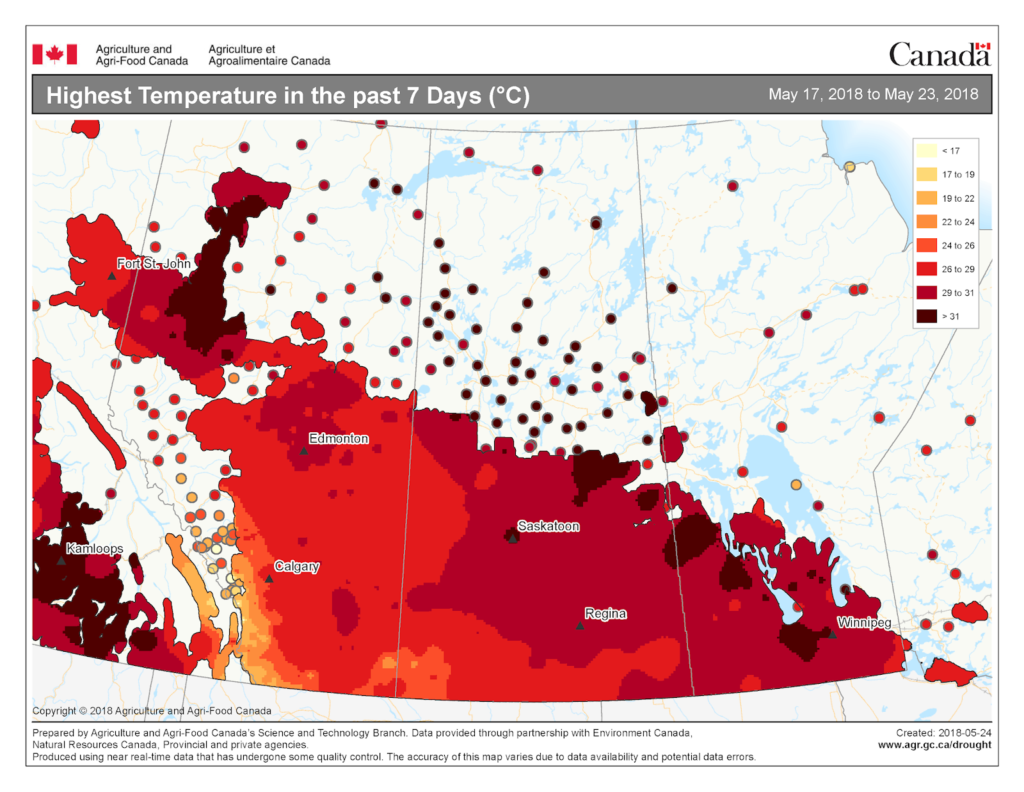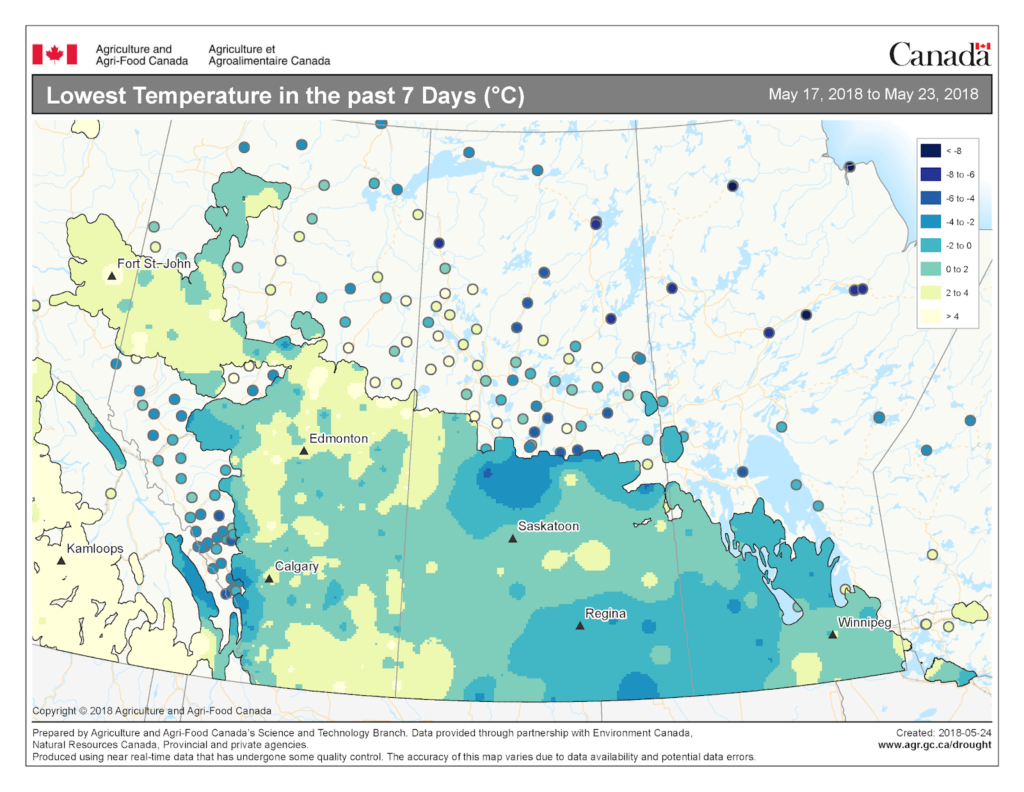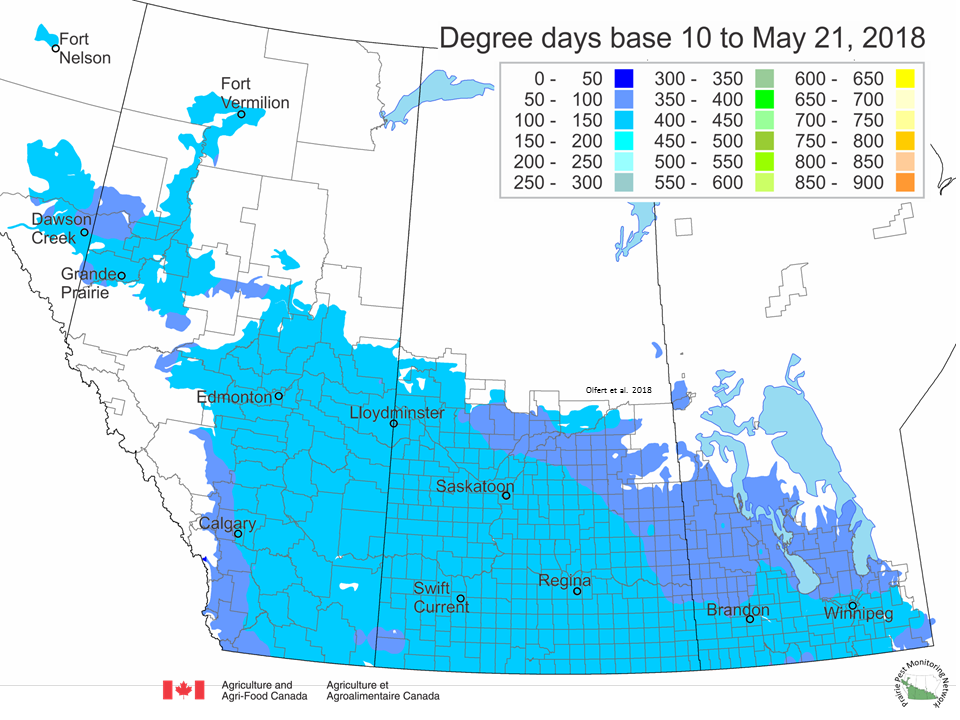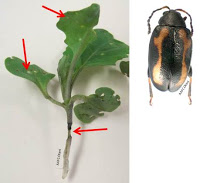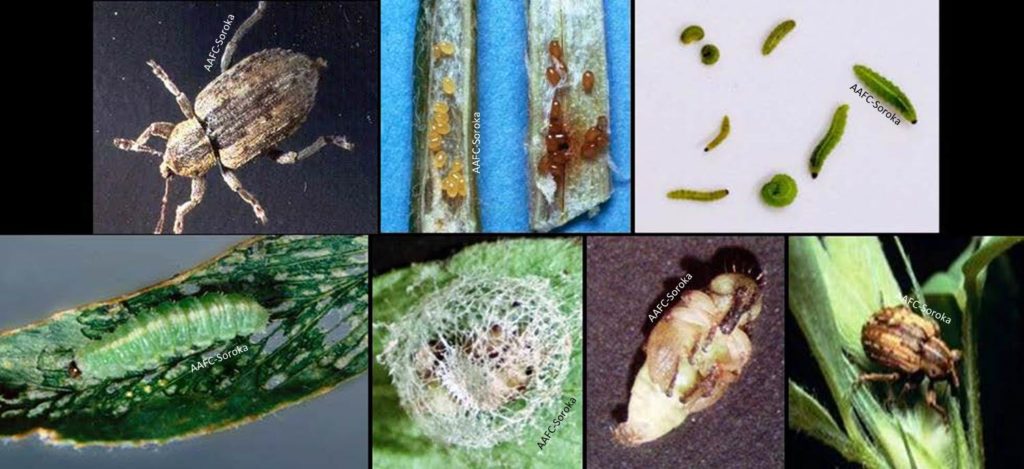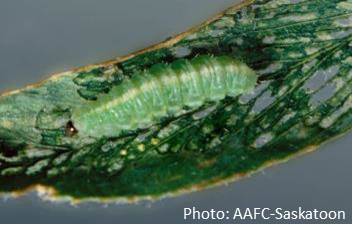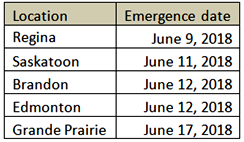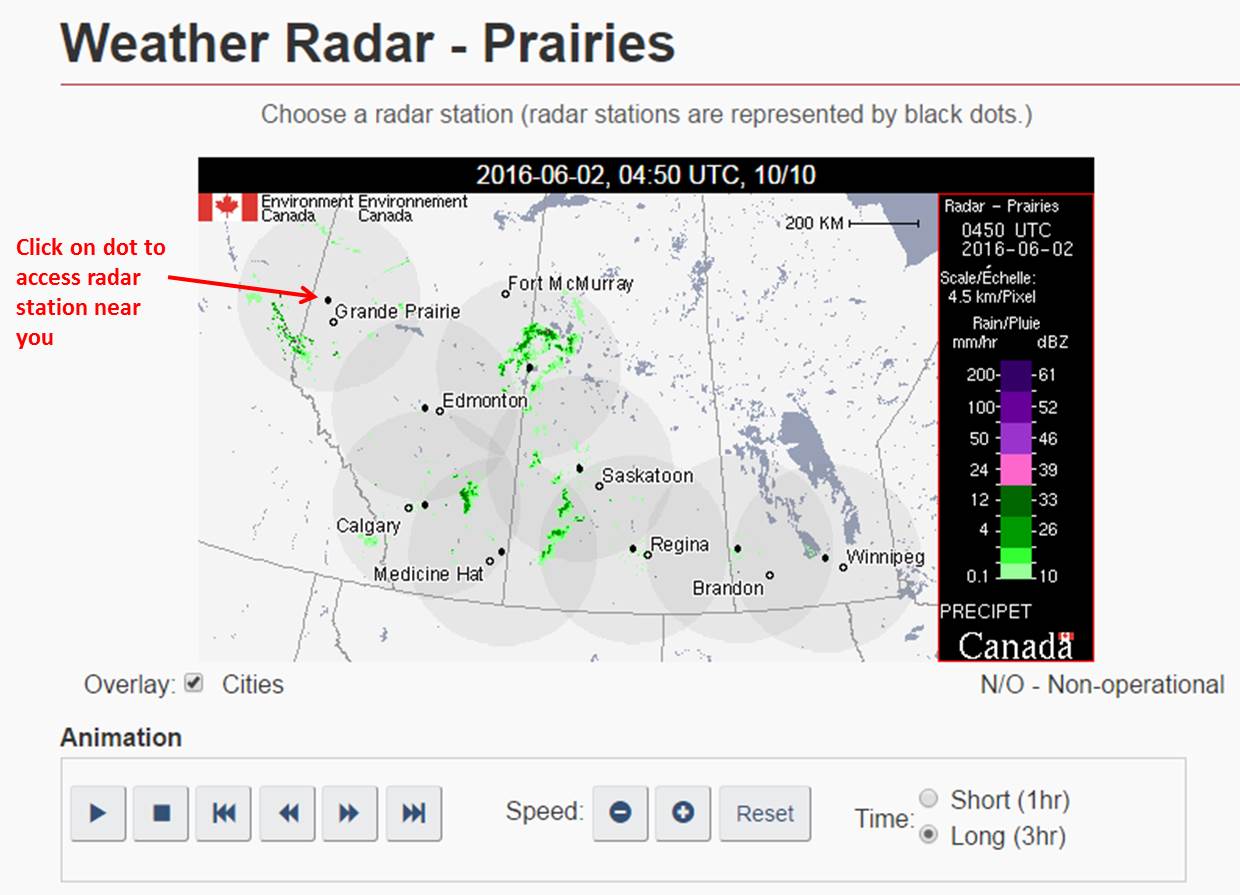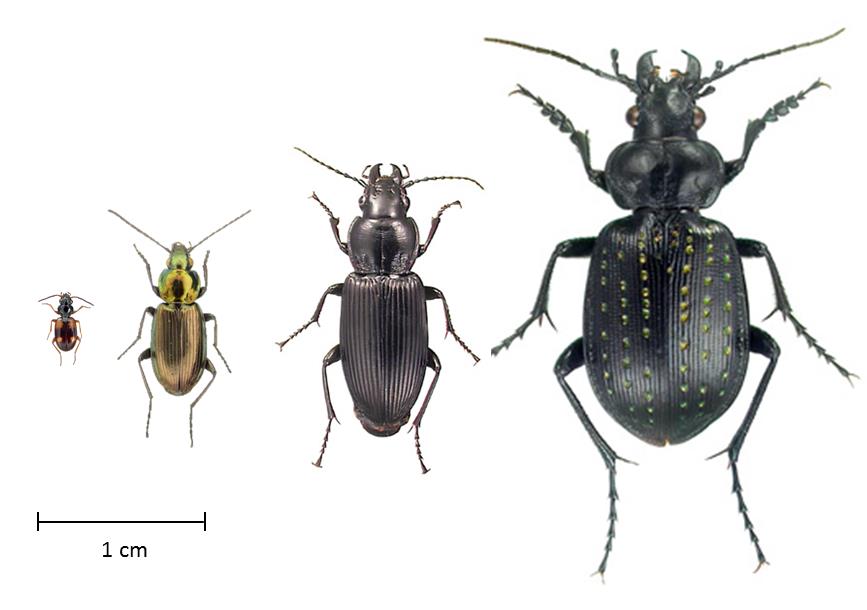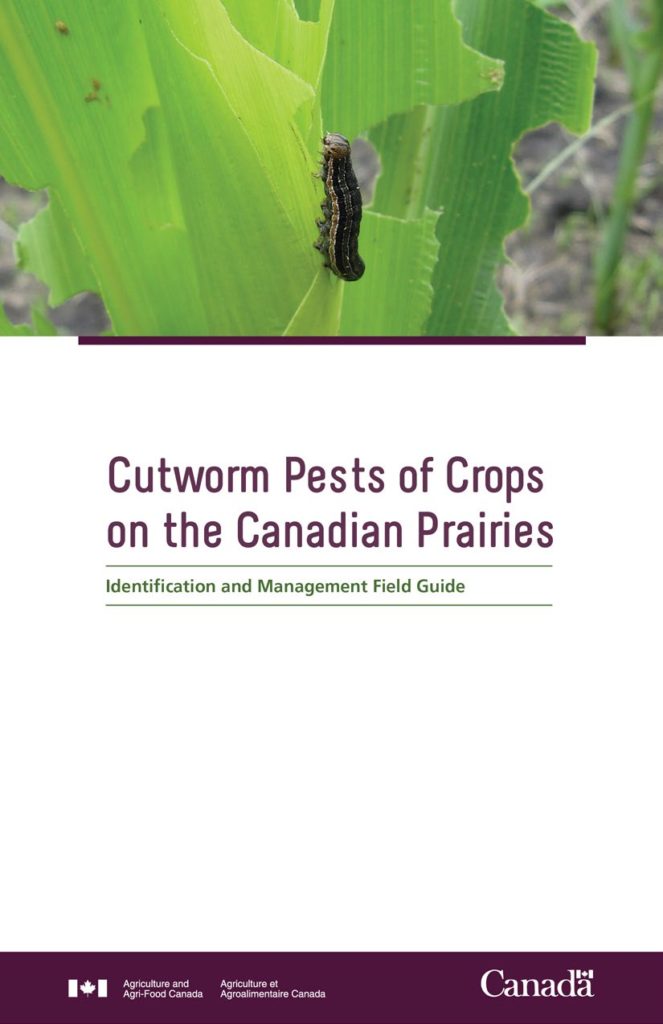Greetings!
Access the complete Weekly Update either as a series of Posts for Week 03 (May 24, 2018) OR a downloadable PDF version. Also review the “Insect of the Week” for Week 3!
-
Weekly Update -
Weather synopsis -
Wind trajectories -
Cutworms -
Flea beetles -
Cereal leaf beetle -
Alfalfa weevil -
Pea leaf weevil -
Predicted grasshopper development -
Predicted bertha armyworm development -
Weather Radar -
Ticks and Lyme Disease -
Scouting Charts – Canola and Flax -
PMRA Pesticide Label Mobile App -
Provincial Insect Pest Reports -
Crop reports -
Previous Posts -
Insect of the Week – Ground beetles: cutworm natural enemies
Weather synopsis
Weather synopsis – Across most of the prairies, weather conditions continue to be warmer and dryer than average. This past week (May 14-21, 2018), the average temperature was approximately 2 °C warmer than long-term average temperatures (Fig. 1). The warmest weekly temperatures occurred across AB and west-central Saskatchewan. The 30-day average temperature (April 21-May 21) was 1-2 °C warmer than long term average temperatures with the warmest conditions occurring the western half of the prairies (Fig. 2).
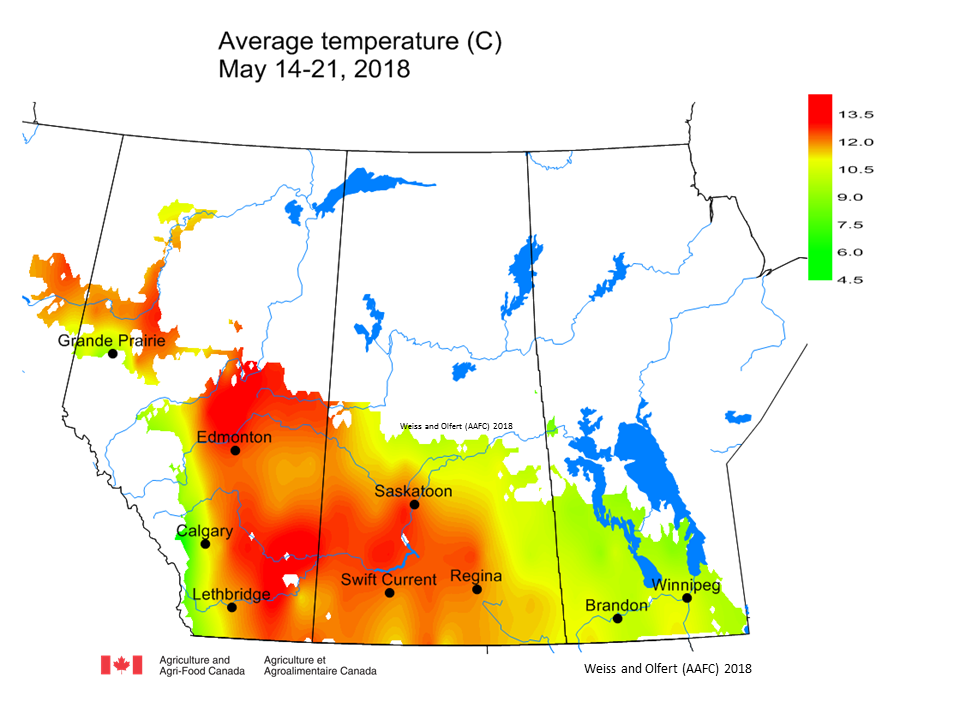 |
| Figure 1. Weekly (May 14 – May 21, 2018) average temperature (°C) . |
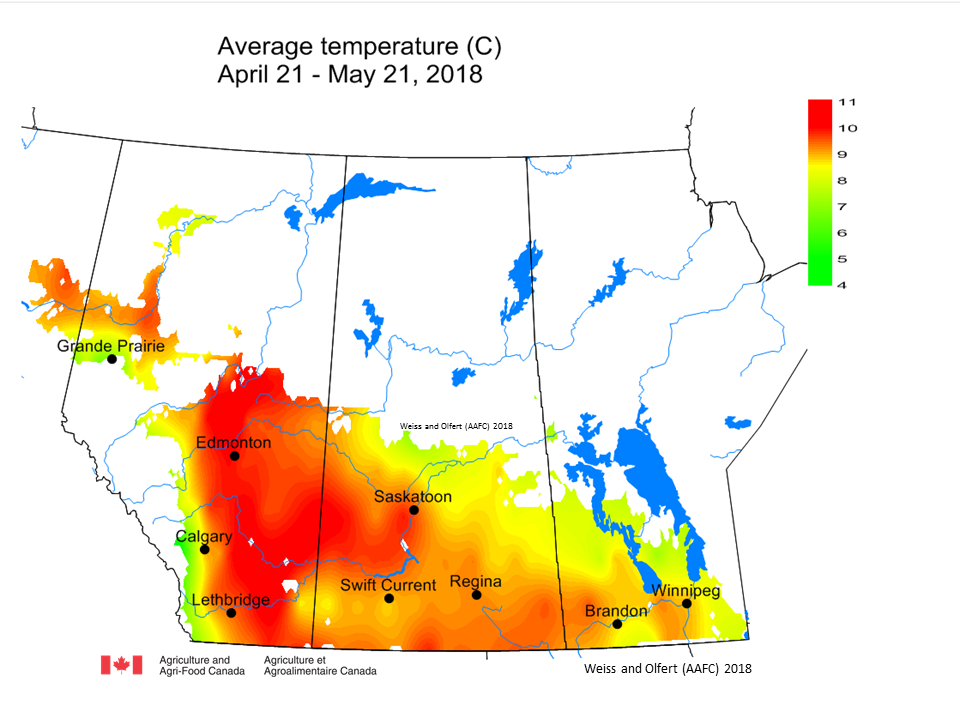 |
| Figure 2. 30-day (April 21 – May 21, 2018) average temperature (°C). |
Weekly precipitation was well below average and 30 day total rainfall is approximately 50% less than average (Figs. 3 and 4). Manitoba continues to be very dry, though this week southeast Manitoba did receive rainfall amounts that were greater than 30 mm.
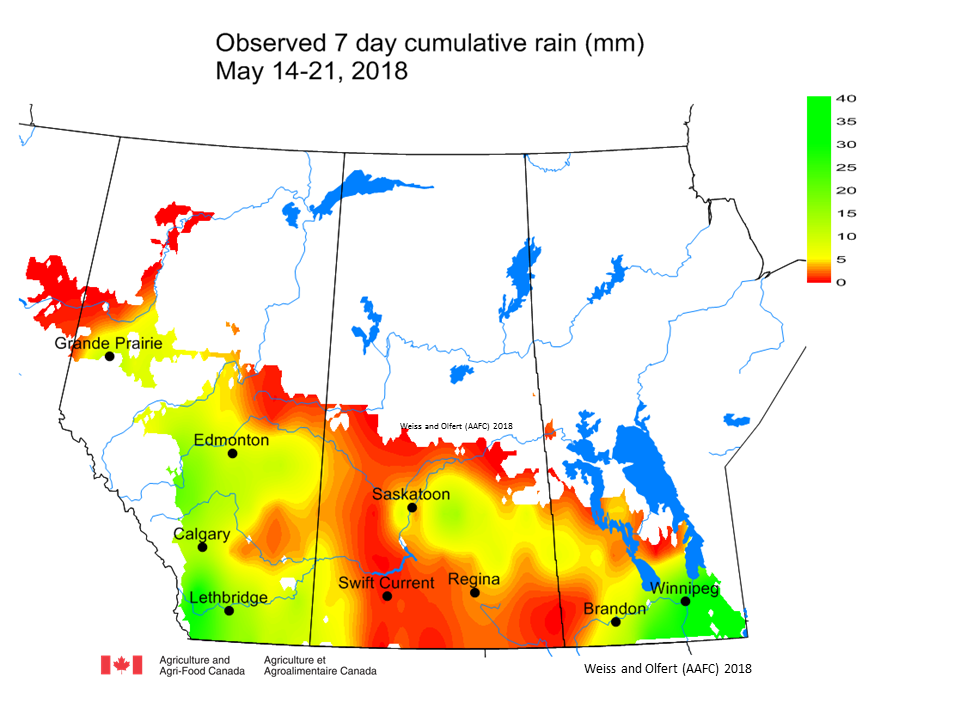 |
| Figure 3. Weekly (May 14 – 21, 2018) cumulative precipitation (mm). |
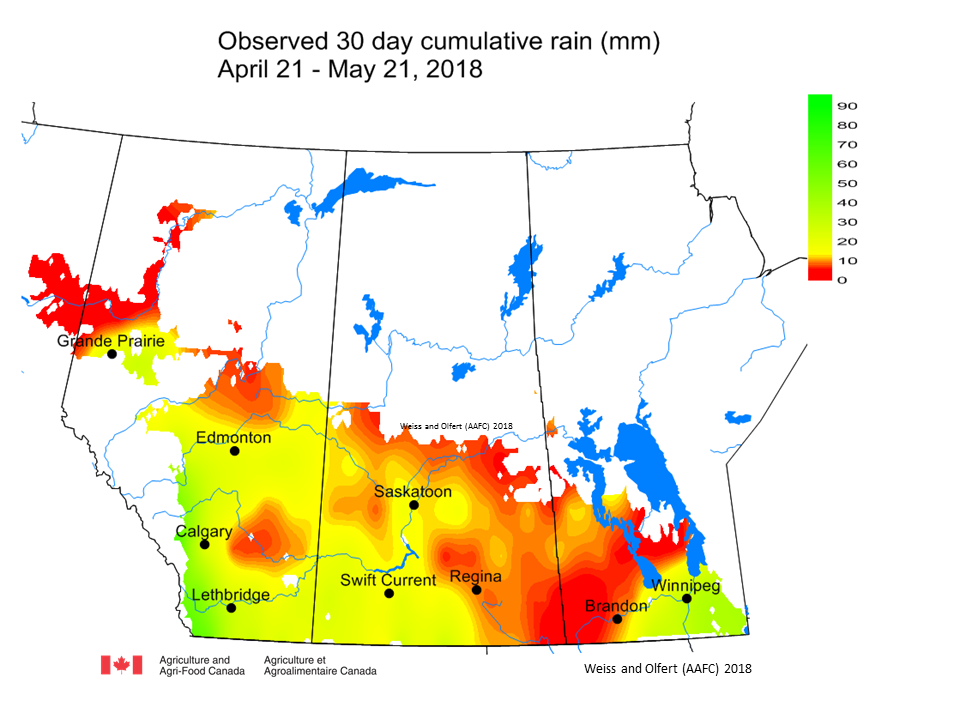 |
| Figure 4. 30 day (April 21 – May 21, 2018) cumulative precipitation (mm). |
The map below reflects the Highest Temperatures occurring over the past 7 days (May 17-23, 2018) across the prairies.
The map below reflects the Lowest Temperatures occurring over the past 7 days (May 17-23, 2018) across the prairies.
The growing degree day map (GDD) (Base 10ºC, March 1 – May 21, 2018) is below:
The growing degree day map (GDD) (Base 5ºC, March 1 – May 21, 2018) is below:
The maps above are all produced by Agriculture and Agri-Food Canada. Growers may wish to bookmark the AAFC Drought Watch Maps for the growing season.
SHARE THIS POST
Wind trajectories
Background. Agriculture and Agri-Food Canada (AAFC) and Environment and Climate Change Canada (ECCC) have been working together to study the potential of trajectories to deliver an early-warning system for the origin and destination of migratory invasive agricultural pests.
We receive two types of model output from ECCC: reverse trajectories (RT) and forward trajectories (FT):
(i) ‘Reverse trajectories’ (RT) refer to air currents that are tracked back in time from specified Canadian locations over a five-day period prior to their arrival date.
(ii) ‘Forward trajectories’ (FT) have a similar purpose; however, the modelling process begins at sites in USA and Mexico. The model output predicts the pathway of a trajectory. Again, of interest are the winds that eventually end up passing over the Prairies.
Current Data
Pacific Northwest (PNW) – The total number of RT’s from the Pacific Northwest of the United States, for the period between May 1 – 22, 2018, was n=67. This was significantly less than in 2017 (n=226), as well as the long term average (n=166) (Fig. 1).
 |
|
| Figure 1. Daily total number of reverse trajectories originating over the Pacific Northwest of the United States that have entered the prairies (May 1-22, 2018). |
Weather forecasts (7 day):
SHARE THIS POST
Cutworms
Cutworms (Noctuidae) – A field guide is now available to help growers scout and manage Cutworms! Cutworm Pest of Crops is available for free in either English or French and is posted on the Cutworm Field Guide page! Also be sure to check the Insect of the Week through May – it highlights cutworms.
Several species of cutworms can be present in fields. They range in colour from shiny, opaque, to tan, to brownish-red with chevron patterning. Cutworm biology, species information, plus monitoring recommendations are available in the Prairie Pest Monitoring Network’s Cutworm Monitoring Protocol. Also refer to Manitoba Agriculture cutworm fact sheet which includes action and economic thresholds for cutworms in several crops.
Scout fields that are “slow” to emerge, are missing rows, include wilting or yellowing plants, have bare patches, or appear highly attractive to birds – these are areas warranting a closer look. Plan to follow-up by walking these areas later in the day when some cutworm species move above-ground to feed. Start to dig below the soil surface (1-5 cm deep) near the base of a symptomatic plant or the adjacent healthy plant. If the plant is well-established, check within the crown in addition to the adjacent soil. The culprits could be wireworms or cutworms.
The following page extracted from the new “Cutworm Pests of Crops on the Canadian Prairies” (Floate 2017; Page 5) shows the seasonal occurrence of lifecycle stages for different species of cutworms. To aid scouting, the seasonal chart outlines what time of year larvae of different pest species are present (i.e., when to scout) but it also describes larval feeding habit (i.e., where to look for them relative to the plant host).
For Albertans….. If you find cutworms, please consider using the Alberta Pest Surveillance Network’s “2018 Cutworm Reporting Tool”. Once data entry occurs, growers can view the live 2018 cutworm map which is updated daily (see below for the map retrieved May 24, 2018).
SHARE THIS POST
Flea beetles
Flea Beetles (Chrysomelidae: Phyllotreta species) – Be on the lookout for flea beetle damage resulting from feeding on canola cotyledons but also on the stem. Two species, Phyllotreta striolata and P. cruciferae, will feed on all cruciferous plants but they can cause economic levels of damage in canola during the seedling stages.
Remember, the Action Threshold for flea beetles on canola is 25% of cotyledon leaf area consumed. Watch for shot-hole feeding in seedling canola but also watch the growing point and stems of seedlings which are particularly vulnerable to flea beetle feeding.
Estimating flea beetle feeding damage can be challenging. Using a visual guide to estimate damage can be helpful. Canola Watch circulated this article but also use the two images (copied below for reference) produced by Dr. J. Soroka (AAFC-Saskatoon) – take it scouting!
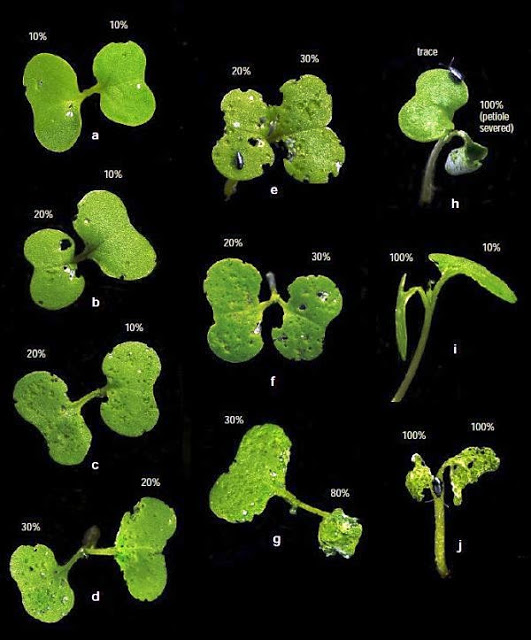 |
| Figure 1. Canola cotyledons with various percentages of leaf area consume owing to flea beetle feeding damage (Photo: Soroka & Underwood, AAFC-Saskatoon). |
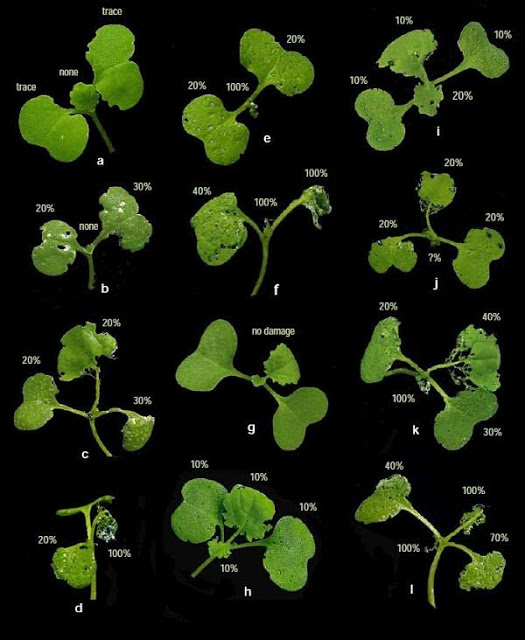 |
| Figure 2. Percent leaf area consumed by flea beetles feeding on canola seedlings (Photo: Soroka & Underwood, AAFC-Saskatoon). |
Refer to the flea beetle page from the “Field Crop and Forage Pests and their Natural Enemies in Western Canada: Identification and management field guide” as an English-enhanced or French-enhanced version.
SHARE THIS POST
Cereal leaf beetle
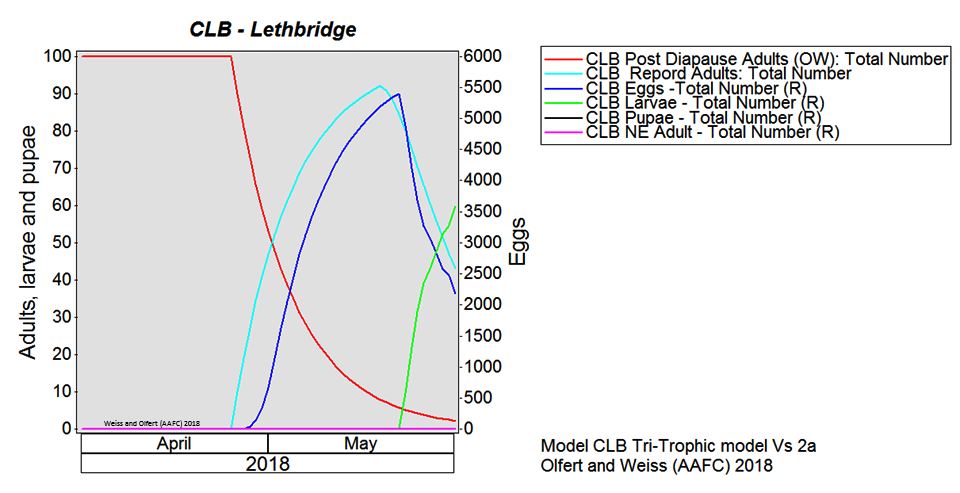 |
| Figure 1. Predicted CLB phenology at Lethbridge. Values are based on model simulations, for April 1 – May 21, 2018 (projected to June 21, 2018). |
Adult: Adult cereal leaf beetles (CLB) have shiny bluish-black wing-covers (Fig. 2). The thorax and legs are light orange-brown. Females (4.9 to 5.5 mm) are slightly larger than the males (4.4 to 5 mm). Adult beetles overwinter in and along the margins of grain fields in protected places such as in straw stubble, under crop and leaf litter, and in the crevices of tree bark. They favour sites adjacent to shelter belts, deciduous and conifer forests. They emerge in the spring once temperature reaches 10-15 ºC and are active for about 6 weeks. They usually begin feeding on grasses, then move into winter cereals and later into spring cereals.
 |
| Figure 2. Adult Oulema melanopus measure 4.4-5.5 mm long (Photo: M. Dolinski). |
Egg: Eggs are laid approximately 14 days following the emergence of the adults. Eggs are laid singly or in pairs along the mid vein on the upper side of the leaf and are cylindrical, measuring 0.9 mm by 0.4 mm, and yellowish in colour. Eggs darken to black just before hatching.
Larva: The larvae hatch in about 5 days and feed for about 3 weeks, passing through 4 growth stages (instars). The head and legs are brownish-black; the body is yellowish. Larvae are usually covered with a secretion of mucus and fecal material, giving them a shiny black, wet appearance (Fig. 3). When the larva completes its growth, it drops to the ground and pupates in the soil.
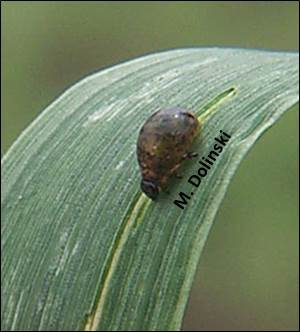 |
| Figure 3. Larval stage of Oulema melanopus with characteristic feeding damage visible on leaf (Photo: M. Dolinski). |
Pupa: Pupal colour varies from a bright yellow when it is first formed, to the colour of the adult just before emergence. The pupal stage lasts 2 – 3 weeks. Adult beetles emerge and feed for a couple of weeks before seeking overwintering sites. There is one generation per year.
SHARE THIS POST
Alfalfa weevil
Alfalfa Weevil (Hypera postica) – Degree-day maps of base 9°C are produced using the Harcourt/North Dakota models (Soroka et al. 2015). Models predicting the development of Alfalfa weevil (Hypera postica) across the prairies are updated weekly to help growers time their in-field scouting for second-instar larvae. Compare the following predicted development stages and degree-day values from Soroka (2015) to the map below (Fig. 1).
The AAW model runs suggest that oviposition should be well underway in southern Saskatchewan. Larvae should be in the first and second instars.
 |
| Figure 1. Predicted development of alfalfa weevil as of May 21, 2018. |
The larval stage of this weevil feeds on alfalfa leaves in a manner that characterizes the pest as a “skeletonizer”. The green larva featuring a dorsal, white line down the length of its body has a dark brown head capsule and will grow to 9mm long.
SHARE THIS POST
Pea leaf weevil
Pea Leaf Weevil (Sitona lineatus) – The PLW model predicts that adult weevils should be out and that oviposition may be occurring in fields with emerging peas. An example of PLW predicted phenology for Swift Current SK is presented in Figure 1.
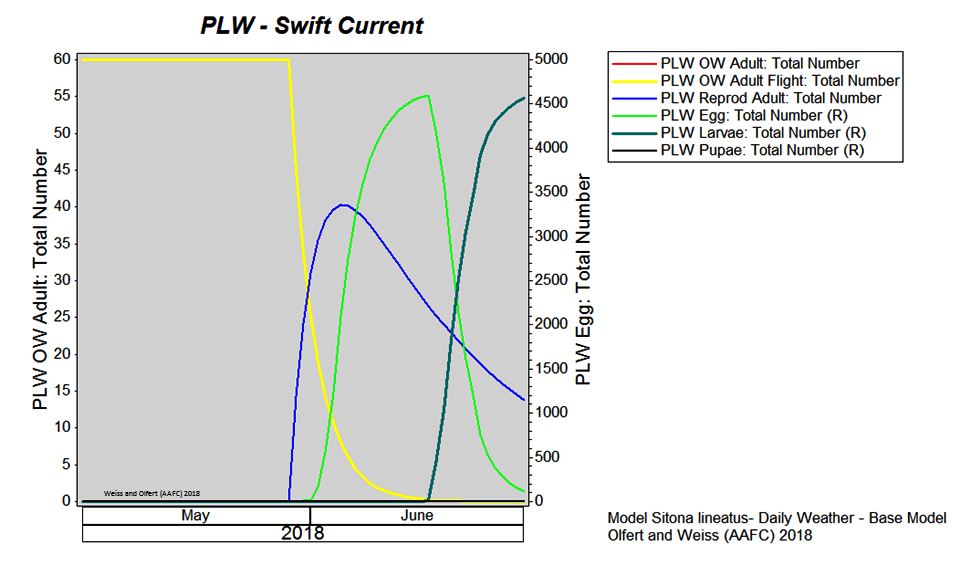 |
| Figure 1. Predicted PLW phenology at Swift Current, SK. Values are based on model simulations, for April 1 – May 21, 2018 (projected to July 1, 2018). |
Pea leaf weevils emerge in the spring primarily by flying (at temperatures above 17ºC) or they may walk short distances. Pea leaf weevil movement into peas and faba beans is achieved primarily through flight. Adults are slender, greyish-brown measuring approximately 5 mm in length (Fig. 2, Left).
The pea leaf weevil resembles the sweet clover weevil (Sitona cylindricollis) but the former is distinguished by three light-coloured stripes extending length-wise down thorax and sometimes the abdomen. All species of Sitona, including the pea leaf weevil, have a short snout.
 |
| Figure 2. Comparison images and descriptions of four Sitona species adults including pea leaf weevil (Left). |
Adults will feed upon the leaf margins and growing points of legume seedlings (alfalfa, clover, dry beans, faba beans, peas) and produce a characteristic, scalloped (notched) edge. Females lay 1000 to 1500 eggs in the soil either near or on developing pea or faba bean plants from May to June.
Reminder – The 2017 risk map for pea leaf weevils was released in March 2018. The map is based on the number of feeding notches observed in peas (Fig. 3).
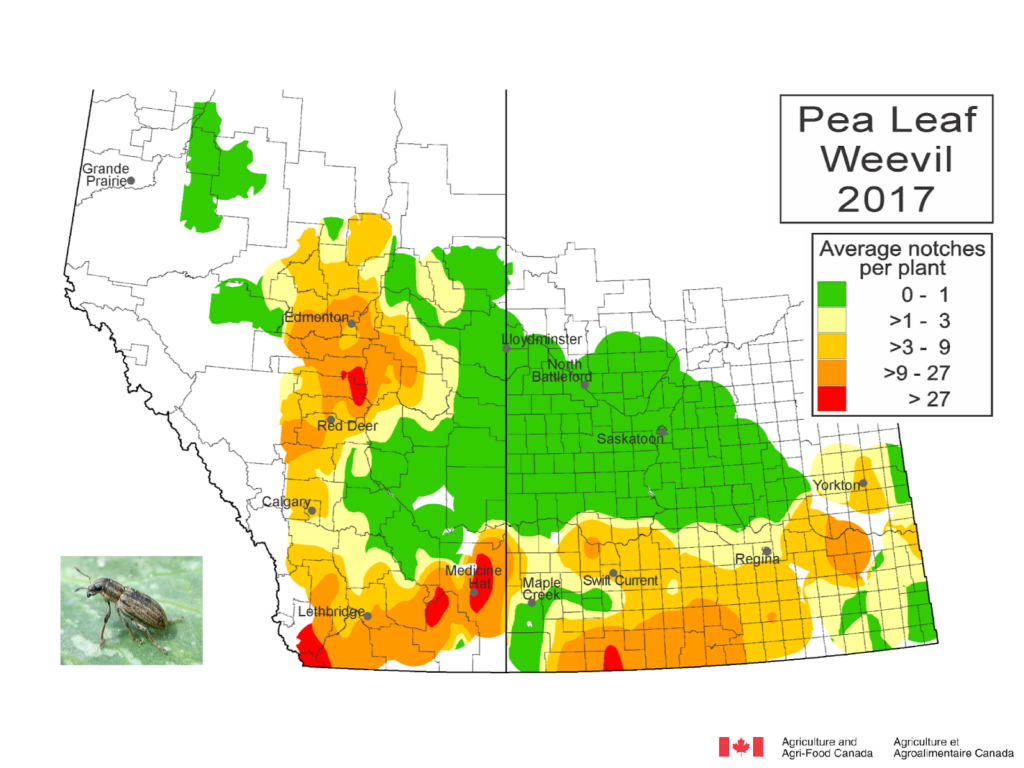 |
| Figure 3. Estimates of pea leaf weevil (S. lineatus) densities based on feeding notches observed in peas grown in Alberta and Saskatchewan in 2017. |
Biological and monitoring information related to pea leaf weevil in field crops is posted by the province of Alberta and in the PPMN monitoring protocol.
SHARE THIS POST
Predicted grasshopper development
Grasshopper Simulation Model Output – The grasshopper simulation model will be used to monitor grasshopper development across the prairies. Weekly temperature data collected across the prairies is incorporated into the simulation model which calculates estimates of grasshopper development stages based on biological parameters for Melanoplus sanguinipes (Migratory grasshopper).
Recent warm conditions have advanced egg development. As of May 21, 2018, predicted mean egg development was 78% (68% last week) and model output indicates that embryological development was 10% greater than long term average. Greatest development was predicted to be across Alberta, particularly in an area extending from Lethbridge to Edmonton (Fig. 1 and 2). Last week first instar grasshoppers were collected near Rosetown SK.
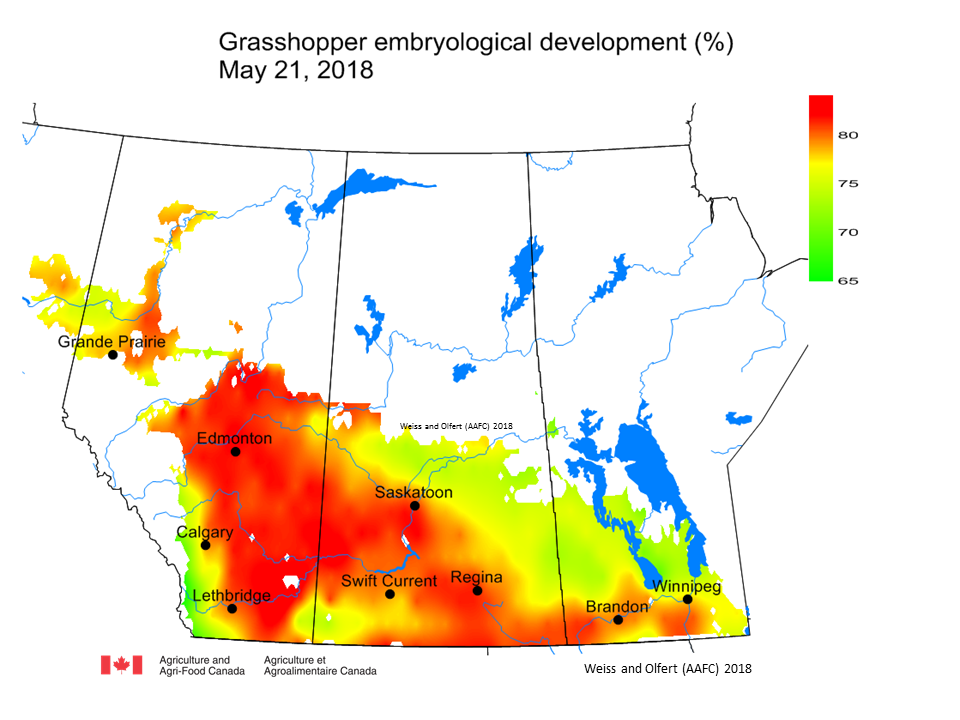 |
| Figure 1. Grasshopper embryological development (%) for April 1 – May 21, 2018, based on model simulations. |
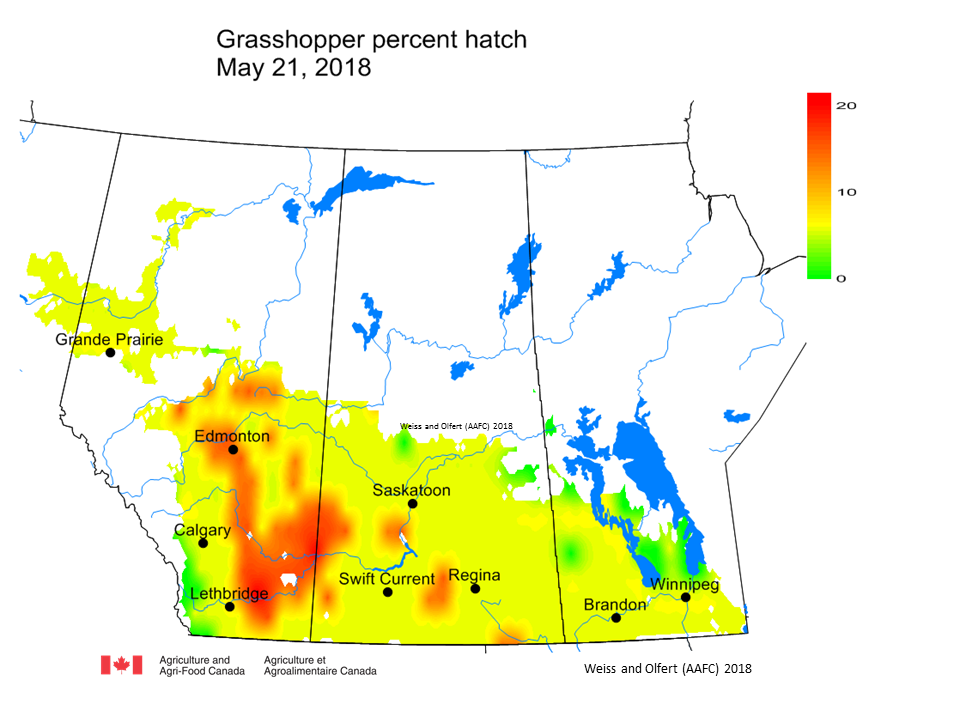 |
| Figure 2. Grasshopper hatch (%) for April 1 – May 21, 2018, based on model simulations. |
Reminder – The Prairie Pest Monitoring Network’s 2018 Grasshopper Forecast Map was released in March (Fig. 3). Spring temperatures, soil moisture conditions, and precipitation all have an impact on survival of overwintered grasshopper eggs. Growers in areas highlighted orange or red in the map below should be vigilant this spring.
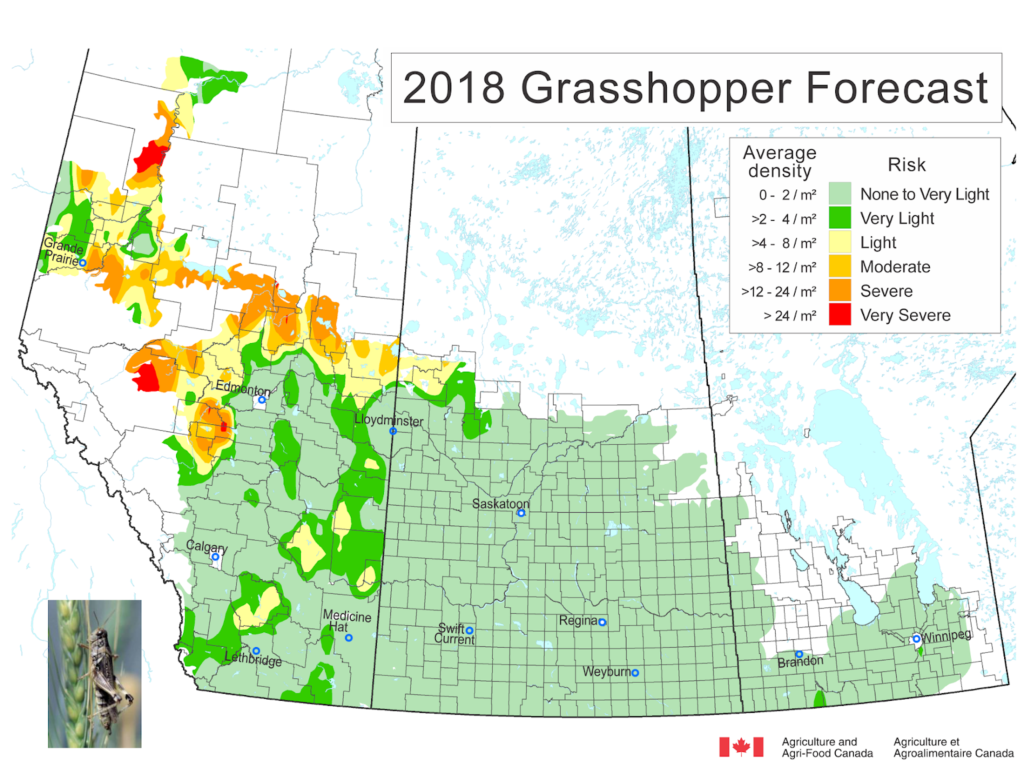 |
| Figure 3. Grasshopper forecast map (M. sanguinipes) for 2018 growing season. |
Biological and monitoring information related to grasshoppers in field crops is posted by Manitoba Agriculture, Saskatchewan Agriculture, Alberta Agriculture and Forestry, the BC Ministry of Agriculture and the Prairie Pest Monitoring Network. Also refer to the grasshopper pages within the new “Field Crop and Forage Pests and their Natural Enemies in Western Canada: Identification and management field guide” as an English-enhanced or French-enhanced version.
SHARE THIS POST
Predicted bertha armyworm development
Bertha armyworm (Lepidoptera: Mamestra configurata) – Bertha armyworm (BAW) – BAW pupae, developing in the soil, are predicted to be ahead of average development. Pupal development is predicted at approximately 50% (Fig. 1) whereas the long term average is 36%.
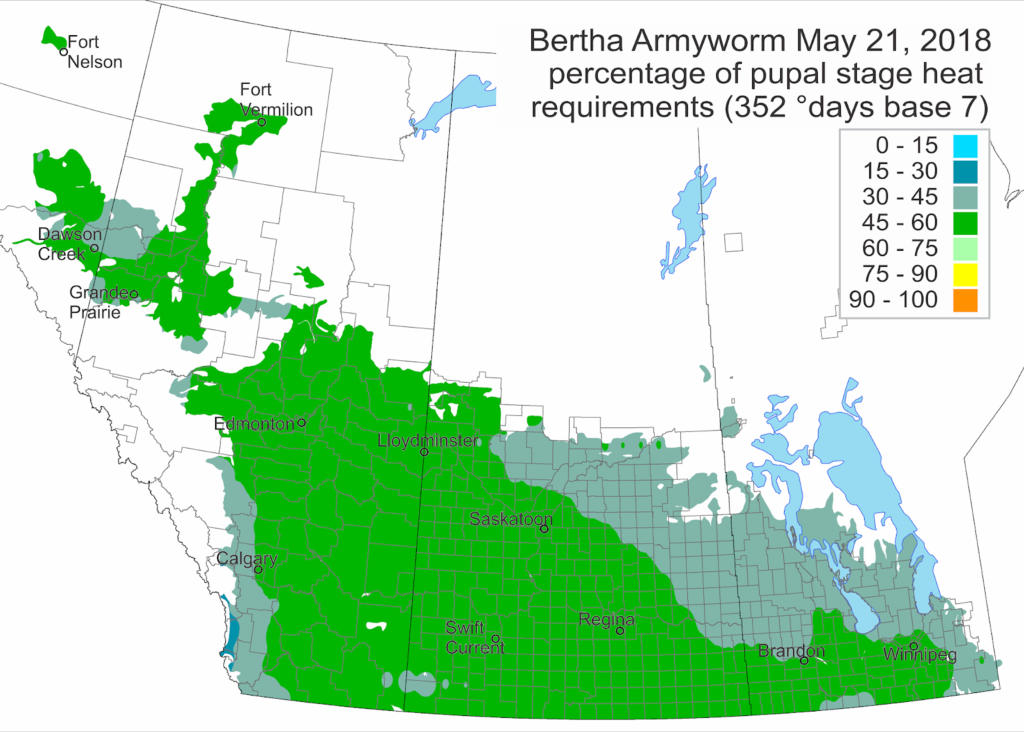 |
| Figure 1. Predicted bertha armyworm pupal development across the prairies as of May 21, 2018. |
Model output predicts that emergence may begin as early as June 9th for the Regina area. Development is expected to be 5-6 days faster than average (Fig. 2; Table 1).
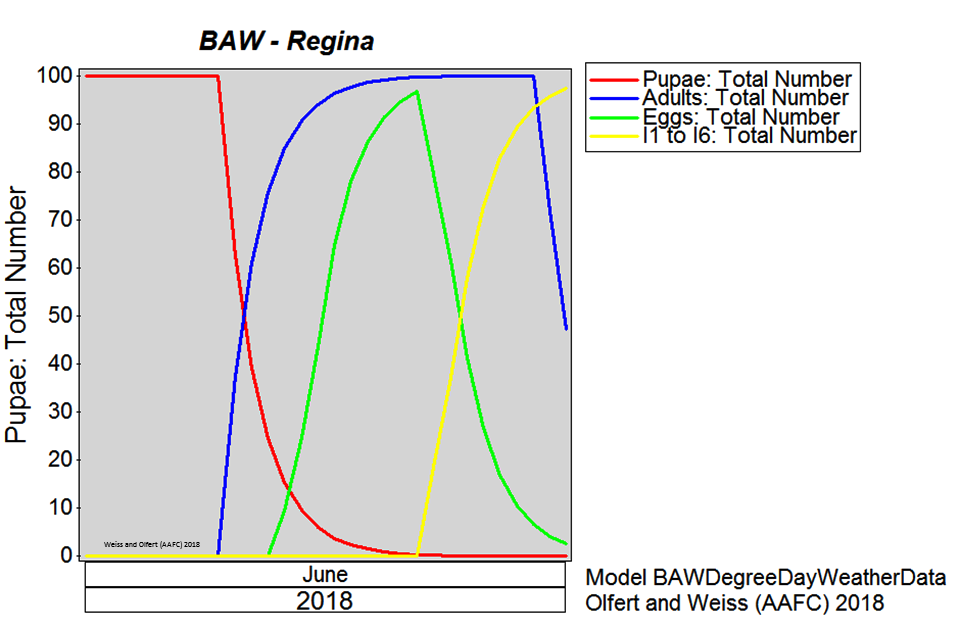 |
| Figure 2. Predicted bertha armyworm phenology at Regina SK. Values are based on model simulations, for April 1 – May 21, 2018 (projected to June 30, 2018). |
Table 1. Projected dates for bertha armyworm adult emergence.
Reminder – Review the 2017 bertha armyworm distribution map for the Canadian prairies which reports cumulative pheromone trap counts intercepting male moths during the 2017 growing season.
Biological and monitoring information related to bertha armyworm in field crops is posted by the provinces of Manitoba, Saskatchewan, Alberta and the Prairie Pest Monitoring Network. Also refer to the bertha armyworm pages within the new “Field Crop and Forage Pests and their Natural Enemies in Western Canada: Identification and management field guide” – both English-enhanced or French-enhanced versions are available.
SHARE THIS POST
Weather Radar
Remember – If your fields are near one of Environment Canada’s PRAIRIE Radar Stations, consider accessing weather radar maps in video format show either the past 1 OR 3 hours of spatio-temporal maps of precipitation events. These maps can help growers review where and how much precipitation fell nearby.
Screen shots of Environment Canada’s webpages are below for reference and red text and arrows have been added to help you navigate the webpage.
SHARE THIS POST
Ticks and Lyme Disease
As the spring weather improves and people are active outdoors, remember to watch for ticks. Blacklegged (deer) ticks are important because they can carry Lyme Disease. Continued surveillance activities conducted by Health Canada and the provinces remain important and you can help by identifying / removing / submitting your ticks!
 |
| Figure 1. Screenshot of Health Canada’s map of Lyme disease endemic and risk areas in Canada (retrieved 24May2018). |
SHARE THIS POST
Scouting Charts – Canola and Flax
Field scouting is critical – it enables the identification of potential risks to crops. Accurate identification of insect pests PLUS the application of established monitoring methods will enable growers to make informed pest management decisions.
We offer TWO generalized insect pest scouting charts to aid in-field scouting on the Canadian prairies:
1. CANOLA INSECT SCOUTING CHART
2. A NEW FLAX INSECT SCOUTING CHART
These charts feature hyperlinks directing growers to downloadable PDF pages within the “Field crop and forage pests and their natural enemies in western Canada: Identification and management field guide“.
Whenever possible, monitor and compare pest densities to established economic or action thresholds to protect and preserve pollinators and beneficial arthropods. Economic thresholds, by definition, help growers avoid crop losses related to outbreaking insect pest species.
Good luck with your scouting!
SHARE THIS POST
PMRA Pesticide Label Mobile App
Remember – Health Canada’s Pest Management Regulatory Agency launched a new mobile app to access pesticide labels registered for use in Canada. The App helps homeowners, farmers, industry, provincial and federal organizations access details for pest control products from a smartphone or tablet (Fig. 1).
Users can save searches, download product labels to their ‘Favourites’ which can even be accessed while offline. ‘Favourites’ will also auto-update when accessed online. Pesticide labels can be searched based by product name or active ingredient (e.g., to review detailed explanations on proper product use and necessary precautions).
Users can download the app on their mobile device.
If you have any questions, please contact the PMRA’s Information Service.
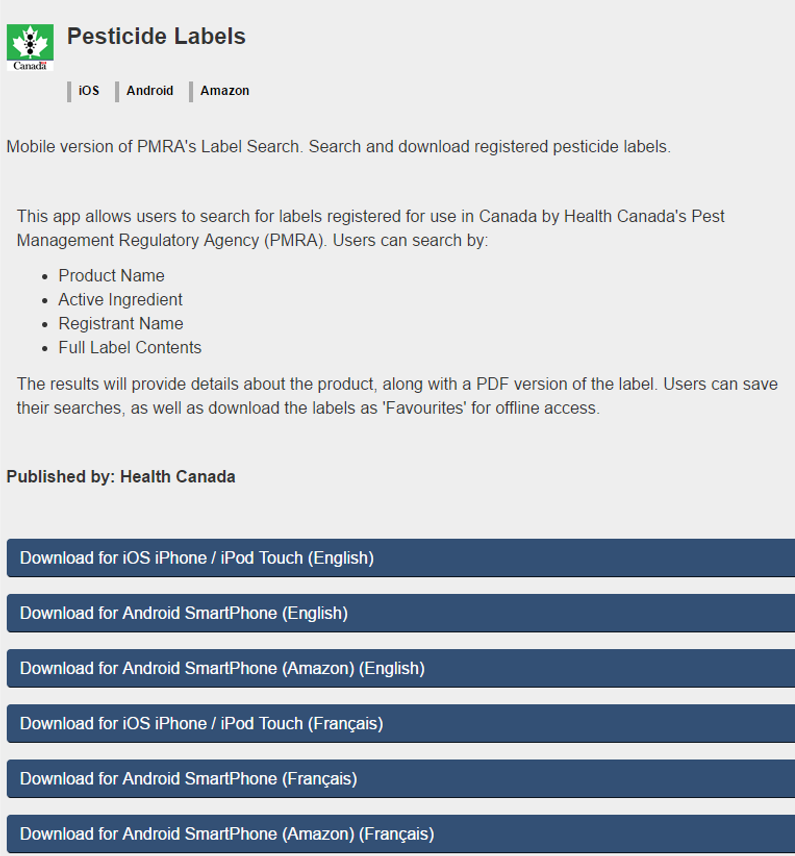 |
| Figure 1. Screenshot view of Pesticide Label download page (retrieved 24May2018).
|
SHARE THIS POST
Provincial Insect Pest Reports
Provincial entomologists provide insect pest updates throughout the growing season so we have attempted to link to their most recent information:
Manitoba’s Insect and Disease Update for 2018 will be posted soon. Watch for updates prepared by John Gavloski.
Saskatchewan’s Crop Production News for 2018 will be posted soon. Watch for updates prepared by James Tansey and Carter Peru.
Watch for Alberta Agriculture and Forestry’s Call of the Land for insect pest updates from Scott Meers. The most recent Call of the Land (posted on May 24, 2018) highlighted flea beetles and need to scout carefully to apply the action threshold of 25% of the cotyledon leaf area consumed, use of the online cutworm reporting tool, and low numbers of diamondback moth so far this spring.
SHARE THIS POST
Crop reports
Crop reports are produced by:
• Manitoba Agriculture, Rural Development (May 22, 2018)
• Saskatchewan Agriculture Crop Report (May 15-21, 2018)
• Alberta Agriculture and Forestry Crop Report (May 15, 2018)
The following crop reports are also available:
• The United States Department of Agriculture (USDA) produces a Crop Progress Report (view the May 21, 2018 edition).
• The USDA’s Weekly Weather and Crop Bulletin (view the May 19, 2018 edition).
SHARE THIS POST
Previous Posts
The following is a list of 2018 Posts – click to review:
Cereal aphid manager (CAM) – Week 2
Crop protection guides – Week 2
SHARE THIS POST
Insect of the Week – Ground beetles: cutworm natural enemies
Almost 400 different species of ground beetles occur on the Prairies, ranging in size from just a few millimetres to more than 2 centimetres. A field may contain 50 or more species, with densities ranging up to 10 beetles per square meter.
 |
|
Adult Carabus nemoralis attacking a bertha armyworm caterpillar.
Photocredit – Vincent Hervet, Agriculture and Agri-Food Canada
|


